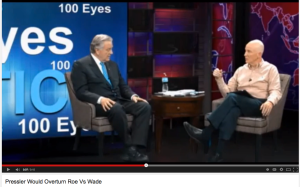Guest post by Noel Holston
Every year, more than 500,000 men in the United States undergo a minor surgery to block sperm from mingling with the semen they ejaculate from their penises. As you probably know, even if you’ve not had one, the procedure is called vasectomy.

A vasectomy doesn’t affect a man’s ability to get an erection or to ejaculate. He still produces seminal fluid; there just aren’t any squiggly-wiggly swimmers in it. The body absorbs the sperm produced by the testes so, in slang terms, a guy fire blanks.
According to the American Urological Association, a vasectomy prevents pregnancy better than any other method of birth control (except, of course, abstaining from sex). Only 1 to 2 women out of 1,000 will get pregnant in the year after their partners have had a vasectomy.
Ponder that statistic as I sketch out a modest suggestion for reducing the number of abortions in our country to near zero, a goal espoused by both pro-choice and anti-abortion advocates.
Almost all vasectomies can be reversed. That being the case, what if we required all males, upon turning 18, the age at which they can vote, to undergo vasectomies?
Once their tubes – they’re called the “vas,” by the way – are snipped and tied and their negative sperm counts have been confirmed, they can resume whatever sex lives they had before the surgery. They’ll still be wise to take precautions, such as condoms, to reduce their chances of spreading or contracting sexually transmitted diseases.
If a man subsequently decides he wants to be the father a child and is intimately acquainted with a woman who wants to be the mother – or if a woman requests a man to make her pregnant – they can apply for a license to reproduce and complete a contract that establishes the responsibilities they expect from each other over the course of the first 18 years of whatever child they bring into the world.
The would-be father will then undergo a vasectomy reversal which, because the healing typically takes 1 to 3 weeks, imposes a de facto waiting period during which he, the would-be mother, or both can have a change of heart.
Unwanted pregnancies under this system would be nearly nonexistent, and abortion, while it would still be available under the same Roe v. Wade terms as now, would be an option seldom exercised.
Downsides?
Well, the mandatory part does violate privacy rights (though not as much as the state commandeering a pregnant woman’s body for nine months). If vasectomy could settle one of our most polarizing issues, isn’t it worth putting to a vote? If the initiative failed, we could always go the voluntary route, backed by a clever advertising campaign and incentives — free football tickets, craft beer, perhaps even cash. It wouldn’t be quite as effective, but it would still improve on the status quo.
No doubt there would be those who would argue that mass vasectomy will increase promiscuity. Perhaps, but recent studies indicate that Americans are engaging in sex less frequently than in the past, when it was more of a taboo and birth control was less accessible and effective. That worry seems moot.
That leaves male fear, which is just plain silly. I had this procedure decades ago. It was a temporary inconvenience. I’ve had no problems and no regrets.
The “V” sign has long stood for victory. Let’s give it another meaning. Let’s win one for the snipper.
Note: Noel Holston is a freelance writer who lives in Athens, Georgia. He’s a contributing essayist to Medium.com, TVWorthWatching.com, and other websites. He previously wrote about television and radio at Newsday (200-2005) and, as a crosstown counterpart to the Pioneer Press’s Brian Lambert, at the Star Tribune (1986-2000). He’s the author of “Life After Deaf: My Misadventures in Hearing Loss and Recovery,” which is scheduled for publication fall of 2019 by Skyhorse.

